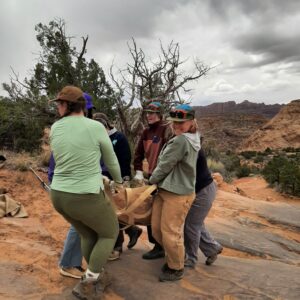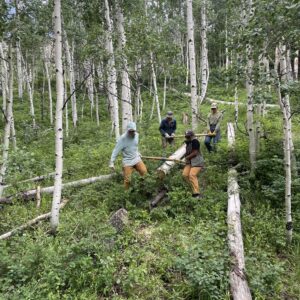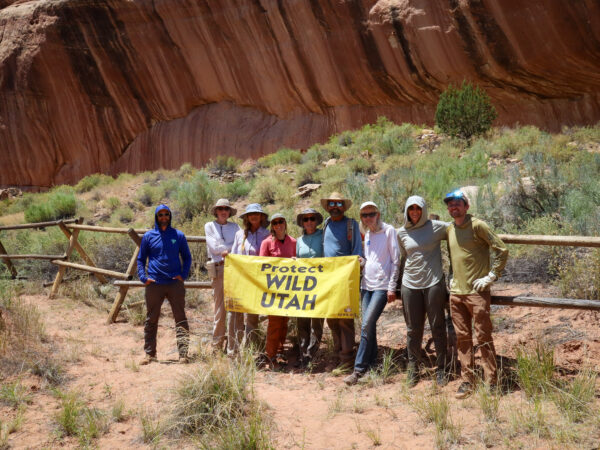A midseason Stewardship update
With the 2024 Stewardship season in full swing, take these snapshots from the spring, during which we conducted twelve volunteer projects across more than fifteen proposed wilderness units, as indicative of our work. Talitha McGuire shares a fine-tuned description of what Stewardship Crew staff see and what we do when our volunteer crew meets on the ground for a stewardship project:

On a mud-struck spring day outside of Moab, Utah, where sand conglomerates into sticky brown silt and the cliffs are gently shrouded in veils of mist, our stewardship team and a group of hardy volunteers encounter a smattering of campsites and nondesignated OHV routes pocking the boundary of a wilderness study area. ATV and dirt bike tires veer from a designated route onto a ridge where delicate soils are crisscrossed by tire treads and several sage and saltbrush are flattened by tires.
We begin our work raking the tracks, taking care to avoid patches of living soil. We fluff compressed soils while erasing tire treads. We collect boulders and dead logs and branches from the surrounding landscape, careful to select only materials that lay in washes or are not already serving some other ecosystem service such as erosion control or providing cover to wildlife. We ‘iceberg’ (half-bury boulders in strategic locations) to deter motorized users from driving off-route. We scatter woody debris following natural patterns such as the flow of surface runoff and the needle drop of pinyon-juniper. To create visual connectivity we ‘deadplant’ (literally replant dead and upturned desert plants) a few small sagebrush skeletons to repopulate the ground.
There is an art to the work that comes with time. We stand back to review our work. What had been a developing nondesignated two-track in a WSA is again a wild landscape boundary designed to prevent future impacts. “Look at everything we just got done!” an enthusiastic volunteer exclaims. “If I were on my own, it would take me days to do what we just did,” a ranger from the Bureau of Land Management (BLM), our federal agency partner on the project, relates.
The Stewardship Crew takes a unite-and-disperse approach – and rarely in less than three places on any given day. As Talitha wraps a day of restoration, Ellie Swanson reflects on a work-in-progress:

At the southern end of the vast Tavaputs Plateau reside the Book Cliffs, the world’s longest continuous escarpment and the site of our stewardship project. Today’s volunteers construct a flood fence barrier across a wash at the entrance to a wilderness study area to protect miles of rugged slopes home to dense bear and elk populations.
Stewardship projects are defined by resilience and collaboration. We read the landscape for cues to its most meaningful restoration. We visit past worksites to observe and document how the landscape changes – and heals – in the wake of our work. We collaborate with BLM rangers who share their knowledge and enthusiasm with volunteers. After a few days on a project, strangers become friends making plans to visit one another in the coming months. Campfire chats provide the basis for substantive comments with unique anecdotes for upcoming travel management plan comment periods. The opportunity to make tangible, positive impacts on the landscape fills the metaphorical cup, allowing each of us to support what SUWA is all about – preserving outstanding wilderness.
Your chance to participate
As we approach a decade of hands-on stewardship projects (the 2025 season will be our 10th!) there is no end in sight because there is no end to the work. This fall we will surpass 160 projects; to date, over 1,300 volunteers have contributed 316 project work days and nearly 20,000 hours of on-the-ground work.
This includes, conservatively, over 280 miles of route remediation, 630,580 square feet of surface restoration (raking, picking, deadplanting, iceberging and vertical mulching), 40,690 feet of fence builds or removal, installation of 538 wilderness and wilderness study area signs, cleaning and remediation of 615 campsites, 10,700 square feet of graffiti removal from sandstone walls, 80 cultural sites surveyed, and over 8,780 lbs of trash removed.

At this moment, Stewardship Crew staff are out on the landscape, traveling far and wide to assess the state of wilderness in national monuments, determine details for our fall projects, and assemble project proposals to submit to the BLM for the 2025 season. As with all efforts at SUWA: persistence is key – and essential.
As we reflect on the season so far, we also invite you to join us on a project – our West Desert, Winter Ridge, and Poison Spring projects in particular need a few additional volunteers. If you have any questions, please do not hesitate to reach out to our team at volunteer@suwa.org or by calling (435) 259-9151.
– Jeremy, Talitha, and Ellie, SUWA’s Stewardship Program

